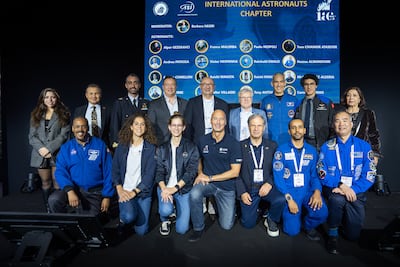From 400km above Earth, astronauts have a unique vantage point that allows them to witness the beauty of the planet, but also the alarming changes it is undergoing.
At this year’s International Astronautical Congress in Milan, a panel of 14 astronauts shared stark observations of how Earth has been visibly transformed by climate change.
They recounted the dramatic shifts they have seen from the International Space Station (ISS) and other space missions.
Soichi Noguchi, a veteran Japanese astronaut who has flown on three spacecraft, highlighted the striking contrasts in the Earth's appearance over the past 15 years.
“When you fly over the polar region, compared to my first flight back 15 years ago, I saw more glaciers. Now, those same areas are visibly melted,” he said, emphasising the melting of polar ice was a “clear and dangerous sign of global warming”.
Mr Noguchi's remarks align with scientific data confirming a dramatic loss of ice mass in the polar regions.
According to Nasa, Greenland is losing an average of 279 gigatonnes of ice per year, while Antarctica loses around 148 gigatonnes annually. These changes contribute to rising sea levels, endangering coastal cities worldwide.

For Italian astronaut Luca Parmitano, who flew to the International Space Station in 2013 and 2019, the most heartbreaking changes are to the Amazon rainforest.
“In 2013, I took pictures of the forest. It was an incredible sight, a constant dark green carpet,” he said. “Only six years later, what I saw was a completely different environment. The man-made fires cleared the forests [of] its trees, and the devastation was visible even from space.”
The Amazon rainforest, often referred to as the “lungs of the planet”, plays a critical role in absorbing carbon dioxide. However, deforestation, much of it caused by deliberate fires, threatens this vital ecosystem.
The World Wildlife Fund estimates that 27 per cent of the Amazon biome will be without trees by 2030 if deforestation continues at its current rate.
Nasa astronaut Mark Polansky, who took part in three space shuttle missions to help build the ISS, spoke about the power of international collaboration in understanding and addressing climate change.
“The ISS was put together to do exactly the type of research we need to help us live a better life on this planet,” he said. “There is a lot of research on climate change, and we have satellites everywhere monitoring the Earth.”
Mr Polansky stressed that beyond their technical mission, astronauts also have a responsibility to act as messengers. “Our job is to go out and make sure that everywhere we go, we spread the message of what we've seen,” he said. “We need to reach receptive audiences and make it clear that this is very important.”
With the ISS ageing, Mr Polansky said that the rise of commercial space stations as future hubs for climate research was important, and that he hopes scientists will use them to continue the legacy of gathering crucial data.
Dangers of spaceflight
Another panel of astronauts at the conference touched on the dangers of spaceflight, with some sharing their most harrowing experiences during missions.
Japanese astronaut Akihiko Hoshide recounted a nerve-racking moment during Expedition 65 in 2021, when the ISS briefly lost attitude control due to an unexpected thruster firing from the newly docked Russian Nauka module.
“The station is usually flying in a stable orientation, but this time we were out of control,” he said. “The alarm went off, and we started working on the problem, along with ground control. After resolving the situation, we later saw an animation of what happened – we did a full 540-degree tumble.”
Nasa astronaut Tony Antonelli shared how his fear of heights added an extra layer of challenge to his space missions. “The scariest part for me was at the launch pad, when the elevator doors open, and you have to walk out over this open steel grating to get to your Space Shuttle,” he said.
“You don’t get to pick your fears, right? You just show up, and you’re afraid,” he said. He added that he was not “the only one that’s flown to space that’s afraid of heights, so if any of you are afraid of heights, you can still fly to space”.

